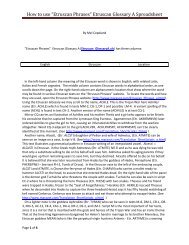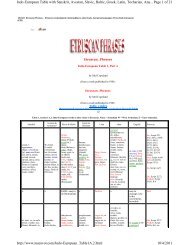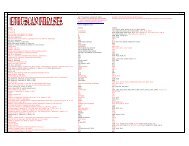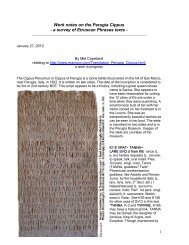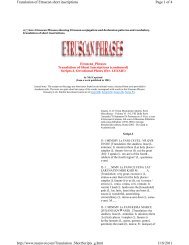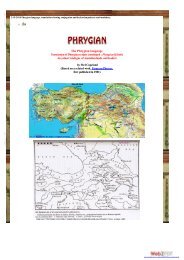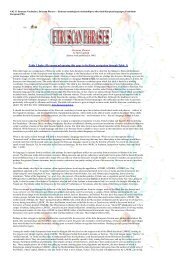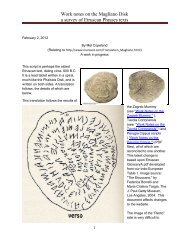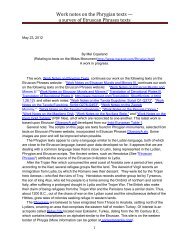Work notes on Etruscan Mirrors and Murals, Part I â - maravot.com
Work notes on Etruscan Mirrors and Murals, Part I â - maravot.com
Work notes on Etruscan Mirrors and Murals, Part I â - maravot.com
- No tags were found...
Create successful ePaper yourself
Turn your PDF publications into a flip-book with our unique Google optimized e-Paper software.
<str<strong>on</strong>g>Work</str<strong>on</strong>g> <str<strong>on</strong>g>notes</str<strong>on</strong>g> <strong>on</strong> <strong>Etruscan</strong> <strong>Mirrors</strong> <strong>and</strong> <strong>Murals</strong>, <strong>Part</strong> I —a survey of <strong>Etruscan</strong> Phrases textsNext to Lasa Thimrae is King Agamemn<strong>on</strong> (Etr. ACHMEMNVN) who is shaking the h<strong>and</strong> ofQueen Helen. (ELINAI). Between them is Menelaüs who appears to be holding a spear in his lefth<strong>and</strong> <strong>and</strong> touching the hair of Helen with his right h<strong>and</strong>. Helen’s h<strong>and</strong> holding a bowl reachesacross the chest of Menelaüs. The presentati<strong>on</strong> of a bowl <strong>and</strong> egg is prominent in <strong>Etruscan</strong>funeral scenes <strong>and</strong> perhaps this scene suggests an eternal b<strong>on</strong>d, as an egg <strong>and</strong> a bowl offeringpromise eternal life to those in <strong>Etruscan</strong> tombs.To Helen’s right are two important characters in the story. The first is a naked youth draped incelestial attire, as in the case of Helen <strong>and</strong> Agamemn<strong>on</strong>, whose name is MENLE (Menelaüs).He is being crowned by an angelic being named MEAN. She has her sign next to her which is adeer. This is the sign of Artemis, the virgin huntress; however, Artemis is featured abundantly inthe <strong>Etruscan</strong> mirrors, so MEAN must be another virgin huntress.MEAN (Latin Maenaas-idis [f], a bacchante, a prophetess) is probably Artemis (the Romanscalled her Diana). Homer (Iliad ii. ; v. 43, xi. 431) refers to the inhabitants of Lydiaas Mai<strong>on</strong>es (Μαίονες). Homer describes their capital not as Sardis butas Hyde (Iliad xx. )[See wikipedia.org <strong>and</strong> www.<strong>maravot</strong>.<strong>com</strong>/Lydian.html].Based up<strong>on</strong> this mirror we may w<strong>on</strong>der how this Trojan Diana / Artemis came to be called Mean,recognizing that the great temple of Ephesian Artemis was nearby. We note that the EphesianArtemis was sculpted as a woman with many breasts, who would certainly not c<strong>on</strong>note a "virginhuntress," but rather the opposite, a mother goddess. However, Diodorus Siculus says:Diodorus: EILEITHYIA, ARTEMIS & THE HOURS[5.73.4] Eileithyia received care of expectant mothers <strong>and</strong> the alleviati<strong>on</strong> of the travail ofchildbirth; <strong>and</strong> for this reas<strong>on</strong> women when they are in perils of this nature call first of allup<strong>on</strong> this goddess.[5.73.5] And Artemis, we are told, discovered how to effect the healing of young children<strong>and</strong> the foods which are suitable to the nature of babes, this being the reas<strong>on</strong> why she isalso called Kourotrophos.Of interest is the fact that in the story of the Arg<strong>on</strong>auts <strong>and</strong> Iphiginia, daughter of Agamemn<strong>on</strong>,Iphiginia is supposed to be sacrificed to Artemis for Agamemn<strong>on</strong>'s boasting. At the last minute adeer nearby was sacrificed up<strong>on</strong> the altar in lieu of Iphiginia, <strong>and</strong> the girl was whisked off to theTaurians al<strong>on</strong>g the Hellesp<strong>on</strong>t where she served as high priest of Artemis. It was a practice bythe king of the Taurians to sacrifice foreigners in the temple of Artemis, <strong>and</strong> when Jas<strong>on</strong> <strong>and</strong> theArg<strong>on</strong>auts arrived <strong>on</strong> the king's coast, Iphiginia helped them escape the sacrificial fire.Diodorus Siculus provides another clue to the identity of MEAN <strong>and</strong> her act of crowningAlex<strong>and</strong>er, as he says that Helen crowned Menelaus:Diodorus: [78] LXXVIII. TYNDAREUSTyndareus, s<strong>on</strong> of Oebalus, by Leda, daughter of Thestius, became father of14



